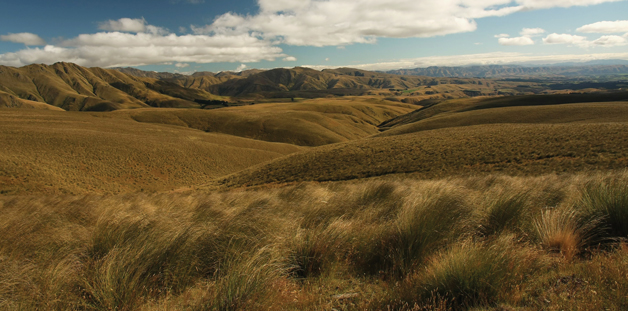He Aitaka a TāneTussocks offer unlikely shelter in a storm
Oct 6, 2015

nā Rob Tipa

Historically, tussock grasslands have not rated highly in terms of their value to the economy.
Before human settlement of Aotearoa, the dominant cover of higher alpine grasslands was large snow tussocks of the Chionochloa family. At lower altitudes, sub-alpine grasslands were primarily dominated by short or low tussocks (less than 50 cm), including a taonga species for Ngāi Tahu – silver tussock (Poa cita) – and hard tussock (Festuca novae-zelandiae).
In the 1840s these short tussocks made up 44 per cent of this country’s total native grasslands, concentrated mainly in drier regions of the central and eastern regions of Te Ika a Māui, and the inland plains, basins, and lower eastern mountain slopes of Te Waipounamu.
Several alpine species of Chionochloa, which grow up to 1.5 m tall, were the dominant species in 13 per cent of the country’s grasslands.
Since human settlement, both alpine and sub-alpine grasslands have been extensively modified and developed by fire, cultivation by horse and tractor for farming, aerial topdressing with lime and fertiliser, and oversowing with imported grasses to make them better suited for grazing livestock.
As development of these natural tussock grasslands for agriculture has accelerated, problems of faster run-off of rainwater, erosion, and nutrient enrichment of waterways have increased; with ongoing negative environmental repercussions.
Today agricultural, political, and environmental leaders acknowledge the benefits of retiring higher altitude grasslands into their natural vegetative cover of tussocks, to improve the harvest of water and slow the rate of rainfall run-off.
Tussocks were known to Māori as wī or pātītī. Interestingly, the only one specifically named on the taonga plants list of Ngāi Tahu is silver tussock (Poa cita).
This fast-growing, densely-tufted species prefers dry soils and has shiny, silvery-green erect foliage. It grows well on exposed, windy sites from sea level to sub-alpine regions up to 1400m.
In historical references, both wī and pātītī were regarded as excellent materials for thatching the roofs of whare, wharenui, or whare rau – small round temporary shelters still used in the Tītī Islands in recent times. Walls were often lined with reeds on the inside and pātītī on the outside to shelter the occupants from the elements.
In Traditional Lifeways of the Southern Māori, researcher Herries Beattie records that the roofs of meeting houses were covered with pukākaho reeds (toetoe) and then thatched with wīwī (rushes) or pātītī (tussocks), the thatch collectively known as rau.
In a whare rau the fire was in the centre of the hut. Scrub or flax was laid on the ground and a thick layer of pātītī was spread over that, and then tiaka (mats) were laid on top for sleeping.
For higher-born individuals a rara (bed) was built by driving poupou (posts) into the ground. Battens were then lashed to them with harakeke, and they were covered with wīwī or mania, which was then covered with pātītī.
Early European settlers mixed tussock fibre with clay to reinforce mud bricks for the construction of substantial cob dwellings and buildings. They also stuffed sacks with tussock to use as mattresses.
When Māori weka hunters were caught out in a thunderstorm in the high country, Beattie recorded that they crawled under clumps of tussocks for shelter. Obviously the taller snow tussocks would have offered better protection from the storm, and in fact the long fronds of this plant were woven into a windbreak or temporary shelter from the elements.
The tussock’s ability to shed water evolved into the development of a waterproof rain cape, known as a pōkeka pātītī, or whītau.
Pōkeka (rain capes) were made from dry flax (koka) overlaid with tussock or pīkau (pīngao), and were regarded as “thoroughly rainproof garments,” Beattie says.
Te Rangi Hīroa (Sir Peter Buck) noted that the fibre of silver tussock was used to make tags and a neck fringe on a rain cape found in a cave on Mt Benger, near Roxburgh in Central Otago. He believed the craftsmanship of weaving techniques for this garment was evidence of links between Aotearoa and the Pacific Islands.
One of the best-known uses of tussocks in the southern mountains was for packing leggings, to protect the bare legs of high country travellers from the fierce taramea (speargrass).
Beattie carefully recorded the technique for making leggings or shin guards, known as tāhau-taupā. First, the ends of pātītī were tucked into the person’s paraerae (sandals), and the lengths of fibre were wound around the legs and bound in place with harakeke (flax).
To keep their feet warm when wading in rivers, Māori stuffed pātītī into their paraerae.
Beattie makes other references of industrial applications of wī and pātītī in the construction of a pā tuna (eel weir). Hard wooden stakes were driven into the riverbed, and a screen of rauaruhe (bracken fern) and pātītī was used to guide tuna along the fence and into a hīnaki (eel pot).
He also records barracouta being split by the pāwhera method and laid on a mat of pātītī before being hung out to dry in the sun.
There are few references to medicinal uses for tussocks, but in Māori Healing and Herbal, Murdoch Riley records the ashes of tussock grass being sprinkled on a burn.
For rheumatic pains Māori used wī, a long white grass; and the roots of tūtunāwai, a swamp plant. A handful of each was boiled for an hour in just enough water to cover them. The water was then allowed to cool, and a tablespoon was taken three times a day.
When we venture into the mountains these days, who would think of tussocks as an excellent windbreak, or for shedding water off your roof or shoulders in a storm?